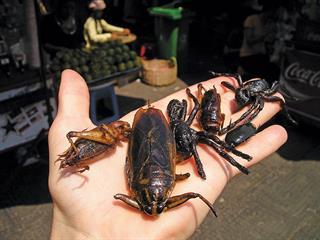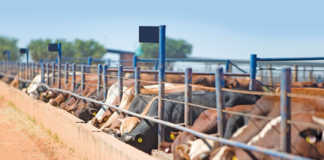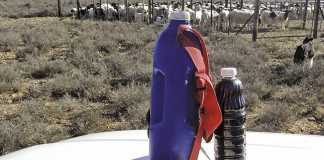
As small as many insects are, they are good sources of protein, fibre, vitamins, minerals, calcium and amino acids, and in these respects outstrip many other types of food sources. Grasshoppers, for example, have the same protein content, gram for gram, as lean beef, but only half the amount of fat. And mealworms have the same protein content as fish.
What’s more, an edible insect such as a cricket requires just 17% of the feed needed by cattle, 25% of the feed required by sheep, and 50% of the feed needed by pigs and broiler chickens to produce the same amount of protein. Considering these figures, more energy should be directed towards farming insects, or at least exploring ways to make them a sustainable food source, according to a UN Food and Agricultural Organisation (FAO) report.
Already a staple in numerous countries
While many people may baulk at the thought of eating caterpillars or grubs, insects already form the staple diet of millions of people worldwide. Entomophagy (consuming insects as food) is practised in almost 100 countries. Of the one million known insect species, more than 2 000 are eaten regularly.
A familiar example in Southern Africa is the mopane worm, the caterpillar of the mopane moth. The caterpillars are taken from the trees, the innards squeezed out and the bodies sprinkled with salt and left to dry in the sun. The caterpillars are then eaten as a snack, or cooked in oil with vegetables and served with pap (maize meal porridge).
They have a rather woody taste and texture. An average-sized teacupful sells for around R12. Of much more limited appeal is Encosternum delegorguei, a species of stink bug, which is killed by dropping it into hot water.
It is then squeezed to remove the smelly contents of the stink glands. In Zimbabwe, it is roasted or dried, while in South Africa it is eaten raw. The bug is said to have the taste of apples.
Interestingly, many species of stink bugs have been found to have analgesic (painkilling) properties, and all are high in Vitamin B.
Common but not yet bred
In African countries that practise entomophagy, locusts, grasshoppers and crickets – all high in protein, vitamins, amino acids and calcium – are most commonly eaten.
According to the FAO, if these could be bred on a large enough scale and marketed in an appealing way, food security in many famine-hit nations could be all but eliminated.
In the US, the farming of insects – mainly crickets – for human consumption is a growing business worth more than US$20 million (about R250 million) a year.
The insects are processed into a variety of commodities, including flavoured snacks, crisps, flour, pies and protein bars.
By being selectively fed a particular flavoured diet, crickets take on that flavour and yield it when processed. At wholesale prices, human-grade cricket flour sells for approximately R370 per 500g.
Commercial rearing of insects is still in its infancy, but as technology advances, the demand for insect-derived produce can only grow.
Source: Halloran A. & Vantomme P. The contribution of insects to food security, livelihoods and the environment.
Retrieved from www.fao.org.













